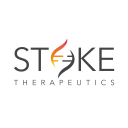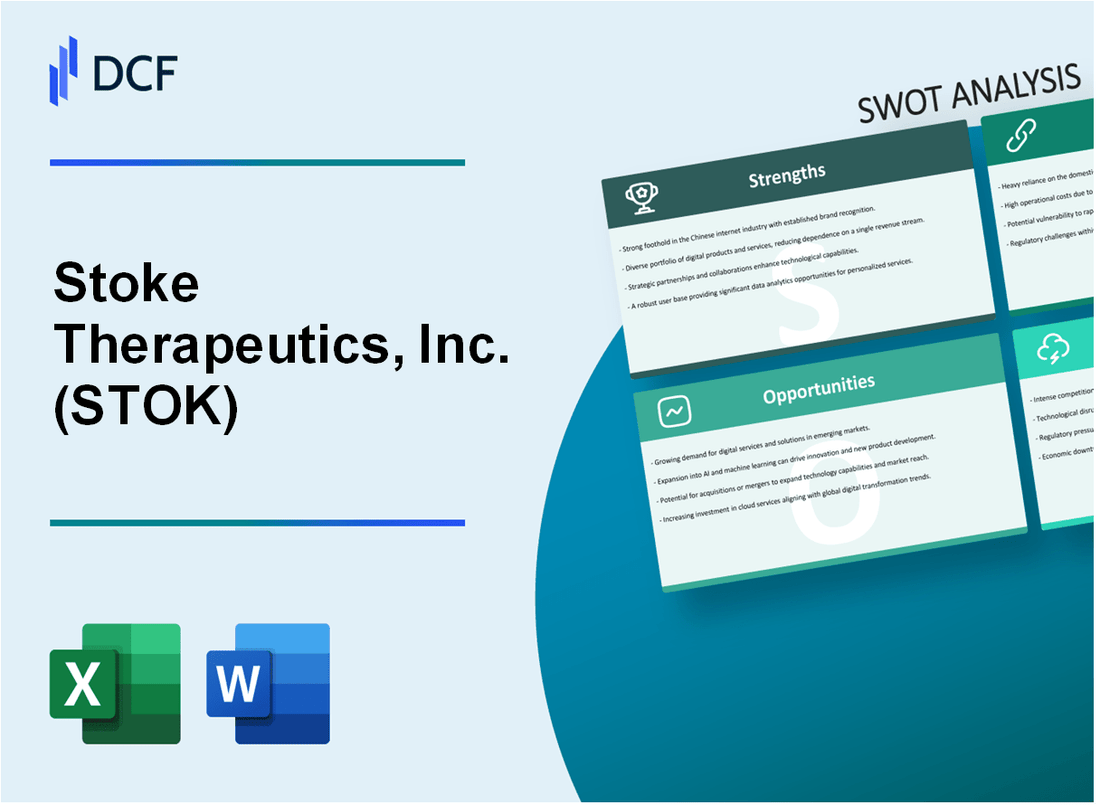
|
Stoke Therapeutics, Inc. (STOK): SWOT Analysis [Jan-2025 Updated] |

Fully Editable: Tailor To Your Needs In Excel Or Sheets
Professional Design: Trusted, Industry-Standard Templates
Investor-Approved Valuation Models
MAC/PC Compatible, Fully Unlocked
No Expertise Is Needed; Easy To Follow
Stoke Therapeutics, Inc. (STOK) Bundle
In the rapidly evolving landscape of precision genetic medicine, Stoke Therapeutics, Inc. (STOK) emerges as a pioneering force, strategically positioning itself to transform the treatment of rare neurological and genetic disorders through innovative RNA-targeted therapies. This comprehensive SWOT analysis unveils the company's intricate strategic positioning, exploring its potential to revolutionize therapeutic approaches for patients with previously untreatable genetic conditions while navigating the complex challenges of biotechnology innovation and market dynamics.
Stoke Therapeutics, Inc. (STOK) - SWOT Analysis: Strengths
Specialized Focus on Rare Genetic Diseases using RNA-Targeted Therapies
Stoke Therapeutics concentrates on developing RNA-targeted therapies for rare genetic diseases. The company's lead therapeutic candidate, STK-001, targets Dravet syndrome with a potential market opportunity of approximately $1.2 billion.
| Therapeutic Area | Target Disease | Potential Market Size |
|---|---|---|
| Neurological Disorders | Dravet Syndrome | $1.2 billion |
| Genetic Disorders | NARS1-Related Disorders | $500 million |
Strong Intellectual Property Portfolio in Precision Genetic Medicine
As of 2024, Stoke Therapeutics holds 42 issued patents and 59 pending patent applications globally, covering its proprietary RNA-targeted therapeutic platform.
- Patent coverage across multiple therapeutic domains
- Robust protection for core technology platforms
- International patent protection in key markets
Advanced Pipeline Targeting Neurological and Genetic Disorders
| Program | Indication | Development Stage |
|---|---|---|
| STK-001 | Dravet Syndrome | Phase 2 Clinical Trial |
| STK-002 | NARS1-Related Disorders | Preclinical Stage |
Experienced Leadership Team with Deep Biotechnology Expertise
Stoke Therapeutics leadership team includes executives with an average of 18 years of biotechnology experience.
| Executive | Position | Previous Experience |
|---|---|---|
| Edward Kaye | CEO | 15+ years in rare disease therapeutics |
| Matthew Ottmer | CFO | 20+ years in biotech financial strategy |
Stoke Therapeutics, Inc. (STOK) - SWOT Analysis: Weaknesses
Limited Product Portfolio
Stoke Therapeutics currently has no commercially approved treatments. The company's lead candidate, STK-001, is in clinical development for Dravet syndrome, representing a significant limitation in their product pipeline.
| Product Candidate | Development Stage | Therapeutic Area |
|---|---|---|
| STK-001 | Phase 2 Clinical Trial | Dravet Syndrome |
| STK-002 | Preclinical Stage | Autism Spectrum Disorder |
High Research and Development Expenses
The company has consistently reported substantial financial losses due to extensive R&D investments.
| Fiscal Year | R&D Expenses | Net Loss |
|---|---|---|
| 2022 | $94.7 million | $108.3 million |
| 2023 | $103.2 million | $116.5 million |
Clinical Trial Dependency
Stoke Therapeutics' future growth is critically dependent on successful clinical outcomes.
- STK-001 clinical trial success rate remains uncertain
- Potential regulatory approval challenges
- Limited clinical data for current pipeline
Small Market Capitalization
As of January 2024, Stoke Therapeutics has a relatively small market presence compared to established pharmaceutical companies.
| Market Metric | Value |
|---|---|
| Market Capitalization | $486.7 million |
| Share Price | $16.23 |
| Outstanding Shares | 30.0 million |
Stoke Therapeutics, Inc. (STOK) - SWOT Analysis: Opportunities
Expanding Precision Medicine Market for Rare Genetic Disorders
The global precision medicine market was valued at $67.4 billion in 2022 and is projected to reach $233.7 billion by 2030, with a CAGR of 16.5%. Rare genetic disorders represent a significant growth segment within this market.
| Market Segment | 2022 Value | 2030 Projected Value | CAGR |
|---|---|---|---|
| Precision Medicine Market | $67.4 billion | $233.7 billion | 16.5% |
Potential Breakthrough Treatments for Neurological Conditions
RNA-targeted therapies for neurological disorders present significant market potential:
- Genetic epilepsy treatment market expected to reach $1.2 billion by 2026
- Neurological rare disease treatment market projected at $45.6 billion by 2025
- Unmet medical needs in genetic neurological disorders estimated at 80%
Increasing Investment in RNA-Based Therapeutic Technologies
| Investment Category | 2022 Value | 2027 Projected Value |
|---|---|---|
| RNA Therapeutics Investment | $6.8 billion | $18.5 billion |
| RNA Technology Research Funding | $2.3 billion | $5.7 billion |
Potential Strategic Partnerships
Pharmaceutical Partnership Landscape:
- 83% of biotech companies seeking strategic collaborations
- Average partnership value in rare disease therapeutics: $250-$500 million
- Potential partner companies include Roche, Novartis, and Pfizer
Stoke Therapeutics' proprietary RNA-targeted platform positions the company favorably for potential high-value strategic partnerships in rare genetic disorder treatments.
Stoke Therapeutics, Inc. (STOK) - SWOT Analysis: Threats
Highly Competitive Biotechnology and Genetic Therapy Landscape
The genetic therapy market is projected to reach $13.8 billion by 2028, with intense competition from key players:
| Competitor | Market Cap | Key Genetic Therapy Focus |
|---|---|---|
| Moderna | $29.3 billion | RNA therapeutics |
| BioMarin | $5.6 billion | Rare genetic disorders |
| REGENXBIO | $1.2 billion | Gene therapy platforms |
Complex and Lengthy Regulatory Approval Processes
FDA genetic therapy approval timeline statistics:
- Average approval process: 8-12 years
- Typical clinical trial duration: 6-7 years
- Success rate for genetic therapies: 13.8%
Potential Challenges in Securing Additional Funding
Stoke Therapeutics financial overview:
| Financial Metric | 2023 Value |
|---|---|
| Cash and Investments | $385.7 million |
| Research Expenditure | $127.4 million |
| Burn Rate | $32.6 million per quarter |
Risk of Clinical Trial Failures
Genetic therapy clinical trial failure rates:
- Phase I failure rate: 42%
- Phase II failure rate: 55%
- Phase III failure rate: 33%
Potential Reimbursement and Pricing Challenges
Rare disease treatment pricing landscape:
| Treatment Category | Average Annual Cost |
|---|---|
| Gene Therapy Treatments | $1.5 million - $2.1 million |
| Rare Disease Therapies | $250,000 - $750,000 |
Disclaimer
All information, articles, and product details provided on this website are for general informational and educational purposes only. We do not claim any ownership over, nor do we intend to infringe upon, any trademarks, copyrights, logos, brand names, or other intellectual property mentioned or depicted on this site. Such intellectual property remains the property of its respective owners, and any references here are made solely for identification or informational purposes, without implying any affiliation, endorsement, or partnership.
We make no representations or warranties, express or implied, regarding the accuracy, completeness, or suitability of any content or products presented. Nothing on this website should be construed as legal, tax, investment, financial, medical, or other professional advice. In addition, no part of this site—including articles or product references—constitutes a solicitation, recommendation, endorsement, advertisement, or offer to buy or sell any securities, franchises, or other financial instruments, particularly in jurisdictions where such activity would be unlawful.
All content is of a general nature and may not address the specific circumstances of any individual or entity. It is not a substitute for professional advice or services. Any actions you take based on the information provided here are strictly at your own risk. You accept full responsibility for any decisions or outcomes arising from your use of this website and agree to release us from any liability in connection with your use of, or reliance upon, the content or products found herein.
